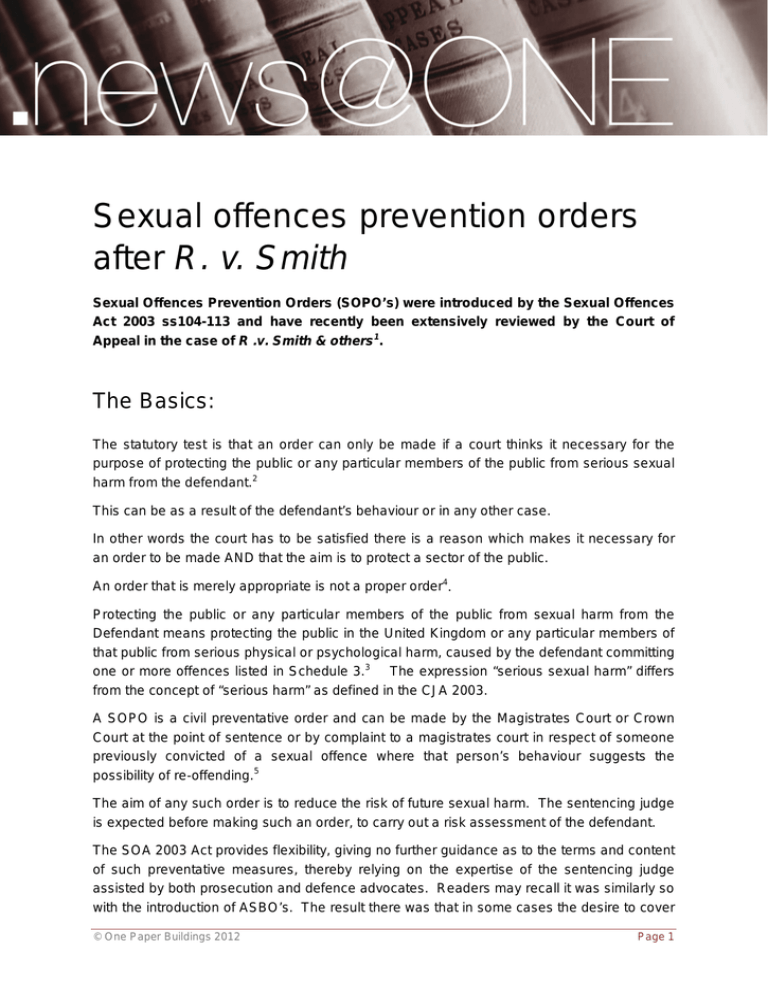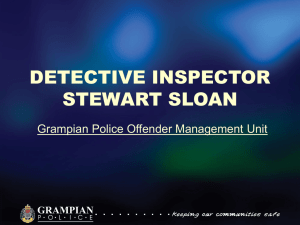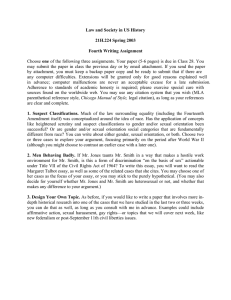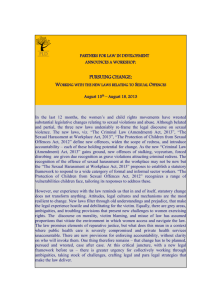
Sexual offences prevention orders
after R. v. Smith
Sexual Offences Prevention Orders (SOPO’s) were introduced by the Sexual Offences
Act 2003 ss104-113 and have recently been extensively reviewed by the Court of
Appeal in the case of R .v. Smith & others 1.
The Basics:
The statutory test is that an order can only be made if a court thinks it necessary for the
purpose of protecting the public or any particular members of the public from serious sexual
harm from the defendant.2
This can be as a result of the defendant’s behaviour or in any other case.
In other words the court has to be satisfied there is a reason which makes it necessary for
an order to be made AND that the aim is to protect a sector of the public.
An order that is merely appropriate is not a proper order4.
Protecting the public or any particular members of the public from sexual harm from the
Defendant means protecting the public in the United Kingdom or any particular members of
that public from serious physical or psychological harm, caused by the defendant committing
one or more offences listed in Schedule 3.3 The expression “serious sexual harm” differs
from the concept of “serious harm” as defined in the CJA 2003.
A SOPO is a civil preventative order and can be made by the Magistrates Court or Crown
Court at the point of sentence or by complaint to a magistrates court in respect of someone
previously convicted of a sexual offence where that person’s behaviour suggests the
possibility of re-offending.5
The aim of any such order is to reduce the risk of future sexual harm. The sentencing judge
is expected before making such an order, to carry out a risk assessment of the defendant.
The SOA 2003 Act provides flexibility, giving no further guidance as to the terms and content
of such preventative measures, thereby relying on the expertise of the sentencing judge
assisted by both prosecution and defence advocates. Readers may recall it was similarly so
with the introduction of ASBO’s. The result there was that in some cases the desire to cover
© One Paper Buildings 2012
Page 1
every eventuality became so great that common sense and an offender’s basic rights were
on occasion forgotten with orders made preventing a Defendant from, for example, being in
the area where he lived.
The danger was always going to be that in sensitive cases involving abuses of a sexual
nature of whatever level, a sledge hammer might be used to crack the nut. I suspect a fear
developed that it was far better to attempt to cover every eventuality rather than risk criticism
should there be further offending in the future. And so inevitably, the number of cases in
which the terms of such orders were argued on appeal began to rise, culminating in the
recent case of Smith which is now essential reading.
The court in Smith held that sexual offences were difficult to sentence. Although a SOPO
might appear to be of comparatively lesser importance, each of its provisions created for the
defendant a personal criminal offence. The order was likely to remain with the defendant for
many years and that the flexibility offered in drafting the order was welcome but must not
lead to an inventiveness which stored up trouble for the future.
Andrew Keogh has, very helpfully, prepared a “toolkit”6 to assist advocates who are given little
notice of the terms of such an order, which I would also suggest, is essential reading for all.
Preparing for a hearing
It is worth remembering that the penalty for breaching the terms of such an order is a
custodial sentence of up to five years and is a separate offence. An order, once imposed, is
likely to be in force for a number of years. Clarity in drafting and ease of interpretation for
those who have to work with the order, the police, probation officers, offenders, relatives and
the courts, is essential.
It is also important to note that an offender is also likely to be subject to further orders which
operate quite separately; notification requirements, a disqualification from working with
children and licence provisions.
Advocates will be expected to be prepared to argue for and against the necessity of the
proposed terms and above all assist the judge as to the nature and level of the terms
required. A properly considered draft should be served by the prosecution in advance of
and not at the hearing (Smith, Buchanan7). This, unfortunately, may not always be the case.
However the procedure is prescribed by the Criminal Procedure Rules, Part 50. Those
making application for a SOPO should make themselves aware of such procedure and also
of the necessity to serve a notice to adduce hearsay evidence should the circumstances
require this. It is likely that the Court of Appeal will begin to criticise such failures more
forcefully and indeed did so in the recent case of R v Lawrence8.
© One Paper Buildings 2012
Page 2
It was suggested in Buchanan that if there is not sufficient time for counsel and the
defendant to consider the terms of the order, application should be made to put the case
back in order for instructions to be made, it being difficult to consider circumstances in which
this would not be allowed.
The drafting of an order:
Hastily and inadequately prepared drafts of orders will be criticised.
Helmsley9 provides guidance. It is essential such orders are:
•
•
•
•
clear on their face
capable of being complied with by the subject without unreasonable difficulty or the
assistance of a third party
free of the real risk of an unintentional breach
carefully drafted, simplicity is a virtue
Buchanan:
•
•
No order should be drawn wider than is necessary to achieve its stated purpose
In the absence of evidence or inference which can properly be drawn, normal activities
should not be prohibited or restrained.
Smith:
•
•
•
•
•
There must be a real rather than remote risk of harm arising from the commission of
further such offences.
Generally, prohibitions on contact with children should relate to those under 16 unless
the specific circumstances of the case justify an extension to children under 18.
Consider whether prohibitions on contact with children are really necessary if the
offence, for example, is one of viewing child pornography10.
If there is no suggestion of risk to a defendant’s own family it is unnecessary to impose
restrictions which extend to them. If such a risk exists any order ought to be subject to
any order made in family proceedings.
A term in a SOPO which prohibits a defendant from activities which were likely to bring
him into contact with children has to be justified as required beyond the restrictions
placed upon him by the Independent Safeguarding Authority under the Safeguarding
Vulnerable Groups Act 2006. Only if there was a real risk that he might undertake some
activity outside those prohibitions might such a term be justified.
Mortimer11 suggests asking 3 questions:
i.Is the making of an order necessary to protect from serious harm through the
commission of scheduled offences?
© One Paper Buildings 2012
Page 3
ii.If some order is necessary, are the terms proposed nevertheless oppressive?
iii.Overall are the terms proportionate?
Common sense would suggest that orders should be no more wordy or complicated than
absolutely necessary. Clauses should be only capable of interpretation in one way.
Content of an order
A SOPO may prohibit a defendant from doing anything set out in the order subject to the
conditions of necessity and public protection. However, only prohibitions may be placed on
an order.
How closely should a SOPO co-exist with notification requirements?
Smith makes it clear a SOPO should not be used to extend notification requirements
beyond the period prescribed by law. A SOPO must operate in tandem with
notification requirements but should not conflict with any of those requirements. The
Court went on to say ordinarily there ought to be little or no overlap between them
and that they are two different things.
Prohibitions should be both necessary and proportionate. For example in Mortimer the Court
held the following blanket prohibitions could not be justified:
•
•
possessing any photo of a child under 16
possessing a computer
Prohibitions which are impossible to police should not be imposed such as:
•
•
•
using the internet other than for work, study or finding employment.
subscribing to, accessing or attempting to access the internet.
possessing a mobile phone capable of accessing the internet/capable of capturing an
image obtained by the internet
Appropriate prohibitions in Smith were as follows:
•
•
•
using any device capable of accessing the Internet unless (i) it has the capacity to retain
and display the history of Internet use and (ii) he makes the device available on request
for inspection by a police officer.
deleting such history.
possessing any device capable of storing digital images unless he makes it available on
request for inspection by a police officer.
In R .v. KL12 the following was also added:
© One Paper Buildings 2012
Page 4
•
using the internet to contact or to attempt to contact any child known or believed to be
under the age of 16.
Any prohibitions on contact with children must exclude incidental contact such was inherent
in everyday life such as contact with an under 16 year old at a shop checkout. There must
also be an identifiable risk of contact offences before a court could impose a prohibition on
unsupervised contact except in the presence of an adult or parent and on permitting such a
child to be in any house where the defendant lived or stayed.
Wording suggested in Smith is:
•
having any unsupervised contact of any kind with any female under the age of 16, other
than:
(i) such as is inadvertent and not reasonably avoidable in the course of lawful daily
life, or
(ii) with the consent of the child's parent or guardian, who has knowledge of his
convictions.
For similar conditions in situations where contact with family members is considered, see
also R .v. N13.
In R v Knowles14 [2011] EWCA Crim 3102 prohibitions from purchasing alcohol, being
intoxicated in any public place between certain hours, and consuming alcohol in any public
place were imposed because the court found that his use of alcohol would often be a
precursor or trigger to his sexual offending.
Length of an order
1. The order can be for a fixed period but of not less than 5 years.
2. Where an indeterminate sentence has been passed the starting point is that a SOPO is
not appropriate at least unless some very unusual feature which means that an order
could add something useful and did not run the risk of tying the hands of the offender
managers later. The court suggested it could not envisage a situation where such
features would exist.
3. On occasion it has been suggested that the length of a SOPO should be commensurate
with the notification period. This is not now the case. It does not follow that the duration
of a SOPO ought generally be the same as the duration of notification requirements. A
SOPO can extend beyond the notification requirements and it may also be possible for a
SOPO to be less than an indefinite period when the notification requirements endure
forever1.
© One Paper Buildings 2012
Page 5
Sexual Offences Sentencing Guidelines:
Para 1.21: One of the purposes of sentencing set out in CJA 2003 is the protection of the
public.
Para 1.23 refers to the obtaining of a victim personal statement – always helpful in cases of
this nature and may also assist in the consideration of terms for a SOPO. In the same way
one would expect a pre-sentence report (the guidelines indicate one should normally be
prepared) to be of assistance as it “may contain information about the sexually deviant
tendencies of an offender”. Buchanan suggests “it will usually be helpful to invite the
probation service to consider whether the management of the risk could be assisted by the
imposition of a SOPO and, if so, the restrictions which might be appropriate
In summary, it is clear that far more attention to detail and focus on the question of necessity
is now required when considering the terms of a SOPO. Following the case of Smith, there
have been a number of successful appeals where the prohibitions imposed on sentence
were clearly too wide. Careful consideration should be given to the proposed terms of a
SOPO prior to the sentencing hearing with attention given to what is necessary based on the
evidence in the particular case.
Nicola Devas
Chambers of Michael Hubbard Q.C. and Karim Khail Q.C.
ONE PAPER BUILDINGS
1.
R .v. Smith (2011) EWCA Crim 1772
2.
S.104 Sexual Offences Act 2003
3.
R .v. Halloren (2004)EWCA Crim 233
4.
S.106 Sexual Offences Act 2003
5.
Sexual Offences Sentencing Guidelines.
6.
Andrew Keogh’s Sexual Offences Prevention Orders advocates toolkit, Crime Line Training Ltd
7.
Buchanan (2010) EWCA Crim 1316
8.
R v Karl Lawrence [2011] EWCA Crim 3185.
9.
Helmsley (2010) EWCA Crim 225
10.
See also R .v. James (2012) EWCA Crim 81
11.
Mortimer (2010) EWCA Crim 1303
12.
R. v. KL12 [2012] EWCA Crim 44
13.
R .v. N (2012) EWCA Crim 62
14.
R v Knowles [2011] EWCA Crim 3102
© One Paper Buildings 2012
Page 6





